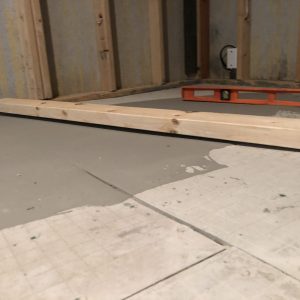Hi y’all!
I am currently converting a shed into a guest house. I am planning to put tile in. The subfloor is OSB and has joists going both directions and I was told by a guy who did tiling for 10+ years that it should be plenty strong enough to hold ceramic tile, however the floor has a dip that causes one part of a side to be lower than the rest, I thought between self leveler and backer board I could get it flush but but after 2 layers of level quick and the backer, it’s still dipping a bit. I to think one more bag of level quick would be enough to get it even but am afraid that it will be too heavy for the floor at that point. Any advice?




















Replies
No, it's not strong enough as is. It's a shed, the framing could be 24" on center and the OSB could be 7/16." I'd put down 3/4" CDX and then mud in a layer of 1/2" cement board for the tile.
If the floor is strong enough for tile adding a few bags of leveling compound won't change anything.
If the floor isn't strong enough to support a few bags of leveling compound then it definitely isn't strong enough for tile.
Can't see it from here, but I suspect you really should have the floor framing evaluated by an engineer. How successful your tile job will be is going to depend partly on the tile you've selected. 4x4 tiles can possibly handle an uneven floor better than 12x18 tiles. The deflection characteristics of the floor framing and floor sheathing will affect the ideal tile selection. Even more important if this is a shed - What's under it? Just bare dirt? Damp environment or bone dry? Older versions of OSB do not fare well in damp environments (it tends to sag).
I don't understand why people are afraid of hiring an engineer to figure out whether
the structure can handle what they want to do. We're not talking a lot of money!!
bing0328: Since it was built as a shed (as OP said), the conditions below the floor should be examined. It's not likely to have a full basement - more like a crawl space probably. Might necessitate some air & moisture management to make the tile investment worthwhile. Environmental conditions can have an adverse effect on wood members, as can insects & critters if they have access.
I agree with everything you say but it is also a structural issue that should be addressed by an engineer.